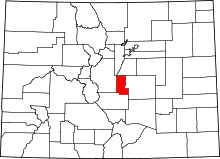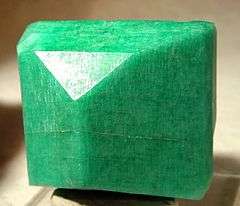Teller County, Colorado
| Teller County, Colorado | ||
|---|---|---|
 Teller County Court House in Cripple Creek | ||
| ||
 Location in the U.S. state of Colorado | ||
 Colorado's location in the U.S. | ||
| Founded | March 23, 1899 | |
| Seat | Cripple Creek | |
| Largest city | Woodland Park | |
| Area | ||
| • Total | 559 sq mi (1,448 km2) | |
| • Land | 557 sq mi (1,443 km2) | |
| • Water | 1.9 sq mi (5 km2), 0.3% | |
| Population (est.) | ||
| • (2015) | 23,385 | |
| • Density | 42/sq mi (16/km²) | |
| Congressional district | 5th | |
| Time zone | Mountain: UTC-7/-6 | |
| Website |
www | |
Teller County is one of the 64 counties in the U.S. state of Colorado. As of the 2010 census, the population was 23,350.[1] The county seat is Cripple Creek,[2] and the most populous city is Woodland Park.
Teller County is included in the Colorado Springs, CO Metropolitan Statistical Area.
History
A few years after gold was discovered in Cripple Creek, political differences between area miners and mine owners, many of whom lived in Colorado Springs, resulted in the division of El Paso County.[3] Created in 1899, Teller County was carved from the western slope of Pikes Peak, and was named after United States Senator Henry M. Teller. Within five years of its formation, Teller County became the scene of a dramatic labor struggle called the Colorado Labor Wars.
Geography
According to the U.S. Census Bureau, the county has a total area of 559 square miles (1,450 km2), of which 557 square miles (1,440 km2) is land and 1.9 square miles (4.9 km2) (0.3%) is water.[4]
Major roads
Adjacent counties
- Douglas County - north
- Jefferson County - north
- El Paso County - east
- Fremont County - south
- Park County - west
National protected areas
- Cripple Creek National Historic District
- Florissant Fossil Beds National Monument
- Pike National Forest
State protected area
Trails and byways
Demographics
| Historical population | |||
|---|---|---|---|
| Census | Pop. | %± | |
| 1900 | 29,002 | — | |
| 1910 | 14,351 | −50.5% | |
| 1920 | 6,696 | −53.3% | |
| 1930 | 4,141 | −38.2% | |
| 1940 | 6,463 | 56.1% | |
| 1950 | 2,754 | −57.4% | |
| 1960 | 2,495 | −9.4% | |
| 1970 | 3,316 | 32.9% | |
| 1980 | 8,034 | 142.3% | |
| 1990 | 12,468 | 55.2% | |
| 2000 | 20,555 | 64.9% | |
| 2010 | 23,350 | 13.6% | |
| Est. 2015 | 23,385 | [5] | 0.1% |
| U.S. Decennial Census[6] 1790-1960[7] 1900-1990[8] 1990-2000[9] 2010-2015[1] | |||
As of the census[10] of 2000, there were 20,555 people, 7,993 households, and 5,922 families residing in the county. The population density was 37 people per square mile (14/km²). There were 10,362 housing units at an average density of 19 per square mile (7/km²). The racial makeup of the county was 94.92% White, 0.55% Black or African American, 0.97% Native American, 0.58% Asian, 0.08% Pacific Islander, 0.90% from other races, and 2.00% from two or more races. 3.49% of the population were Hispanic or Latino of any race.
There were 7,993 households out of which 33.60% had children under the age of 18 living with them, 64.20% were married couples living together, 6.60% had a female householder with no husband present, and 25.90% were non-families. 19.60% of all households were made up of individuals and 4.00% had someone living alone who was 65 years of age or older. The average household size was 2.56 and the average family size was 2.94.
In the county the population was spread out with 25.90% under the age of 18, 5.60% from 18 to 24, 31.20% from 25 to 44, 29.80% from 45 to 64, and 7.50% who were 65 years of age or older. The median age was 39 years. For every 100 females there were 102.70 males. For every 100 females age 18 and over, there were 100.90 males.
The median income for a household in the county was $50,165, and the median income for a family was $57,071. Males had a median income of $37,194 versus $26,934 for females. The per capita income for the county was $23,412. About 3.40% of families and 5.40% of the population were below the poverty line, including 6.90% of those under age 18 and 4.20% of those age 65 or over.
Communities
Gallery
 Amazonite crystal, from Crystal Peak area near Florissant
Amazonite crystal, from Crystal Peak area near Florissant Mountains in Teller County
Mountains in Teller County A ranch home with an airplane in the county
A ranch home with an airplane in the county Casinos in Cripple Creek
Casinos in Cripple Creek Dome Rock, Mueller State Park
Dome Rock, Mueller State Park
See also
- Outline of Colorado
- Index of Colorado-related articles
- Colorado census statistical areas
- Front Range Urban Corridor
- National Register of Historic Places listings in Teller County, Colorado
References
- 1 2 "State & County QuickFacts". United States Census Bureau. Retrieved June 11, 2014.
- ↑ "Find a County". National Association of Counties. Retrieved 2011-06-07.
- ↑ Elizabeth Jameson, All That Glitters—Class, Conflict, and Community in Cripple Creek, 1998, page 168.
- ↑ "US Gazetteer files: 2010, 2000, and 1990". United States Census Bureau. 2011-02-12. Retrieved 2011-04-23.
- ↑ "County Totals Dataset: Population, Population Change and Estimated Components of Population Change: April 1, 2010 to July 1, 2015". Retrieved July 2, 2016.
- ↑ "U.S. Decennial Census". United States Census Bureau. Retrieved June 11, 2014.
- ↑ "Historical Census Browser". University of Virginia Library. Retrieved June 11, 2014.
- ↑ "Population of Counties by Decennial Census: 1900 to 1990". United States Census Bureau. Retrieved June 11, 2014.
- ↑ "Census 2000 PHC-T-4. Ranking Tables for Counties: 1990 and 2000" (PDF). United States Census Bureau. Retrieved June 11, 2014.
- ↑ "American FactFinder". United States Census Bureau. Retrieved 2011-05-14.
External links
- Teller County Profile & Community Bulletin Board
- Teller County Government website
- Teller County Information & Links
- Teller County Online Yellow Pages
- Teller County Real Estate Information
- Colorado County Evolution by Don Stanwyck
- Colorado Historical Society
 |
Douglas County and Jefferson County |  | ||
| Park County | |
El Paso County | ||
| ||||
| | ||||
| Fremont County |
Coordinates: 38°53′N 105°09′W / 38.88°N 105.15°W

